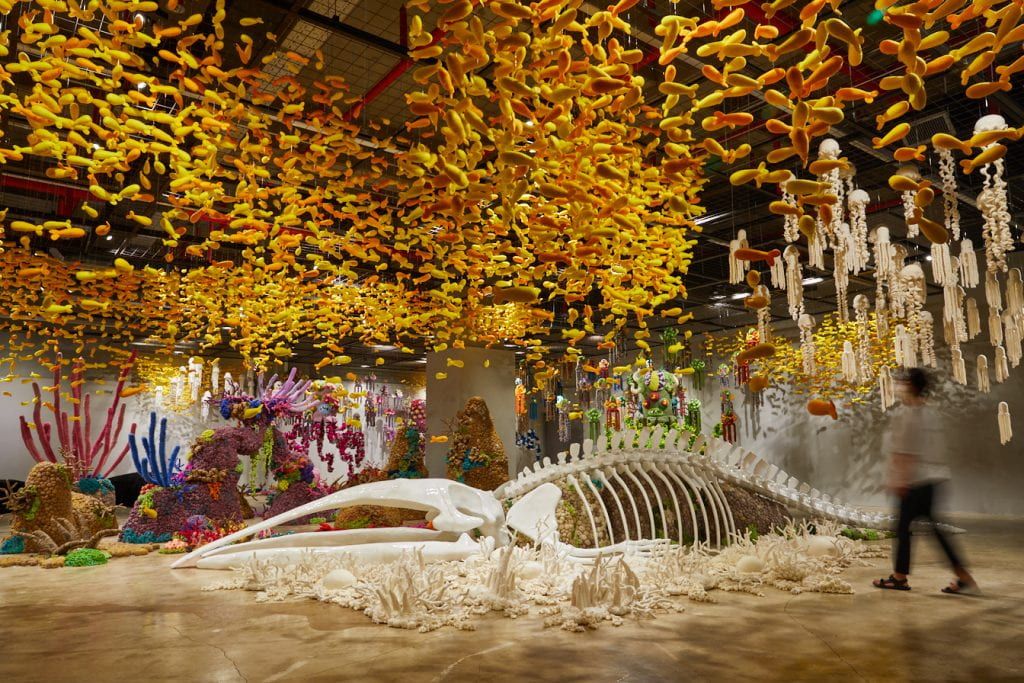On view February 25, 2023 through April 13, 2023

USC Fisher Museum of Art is proud to announce Mulyana: Modular Utopia, the Indonesian artist’s first solo museum exhibition in Los Angeles. The exhibition is an introduction to Mulyana’s large kinetic environments composed of intricately constructed, knit modules of marine life sculptures that vividly portray an unadulterated underwater world. Through the beauty and wonder of his artworks, Mulyana hopes to instill a new consciousness of shared responsibility to protect the environment.
Mulyana’s diverse art practice centers on the themes of sustainability and human flourishing. His studio is based in the town of Yogyakarta, Indonesia, which has been the cultural capital for the visual arts in Indonesia for many decades. Mulyana settled there in 2014 and, from the very beginning, endeavored to create a community-based workshop that would operate as an extension of his practice. The first group of collaborators he employed was a community of transgender women in Sorogenen village, which was the genesis of Mulyana’s signature medium of soft-knit and crocheted sculptures.
Mulyana has chosen knitting and crocheting mediums, allowing him to create various forms of varying scales. For the artist, these hand-knit and hand-built installations are a testament to human endurance and imagination. Mulyana sees the act of knitting as a deliberative, methodical art process, a stark contrast to the fast-paced, contemporary world in which we operate.
In Modular Uptopia, viewers will be greeted by the Si Koneng (2022) and Adikara (2021) costumes that are presented on mannequins of the same proportions as the artist. The central character of Mulyana’s mythology, the Mogus (monster), represents his alter-ego and is an acronym that combines the Gurita (octopus) with his clan name, Sigarantang. Mulyana views his costumes as avatars that more fully embody his personality than his Mogus character is able to achieve. The Si Koneng figure is surrounded by sections of coral islands, titled Candramawa (2022), which are knit and crocheted in multiple shades and textures of gray yarn, and are a stark reminder of the transition from life to the death of the coral reef habitat. These figurative, knit tableaus speak to the universal struggle of becoming comfortable in one’s own skin and finding peace in an era of isolation and uncertainty. In Indonesian culture, masks and costumes are seminal expressions of cultural folklore that signify heroic acts, define religious celebrations or provide entertainment. Costumes can be fashioned to conceal or liberate, and for Mulyana they embody the complexities of his persona, which the Hariwang (2022) performance video enchantingly brings to life.
Ocean Wonderland (2019), one of Mulyana’s most comprehensive installations, will be on view in the adjacent gallery. It depicts a celebratory vision of the ocean habitat that includes many plant and animal life forms. A school of thousands of yellow and orange felt fish is suspended above an underwater landscape of coral reefs, creatures, and a life-size whale. With his work, Mulyana intends to appeal to our collective consciousness and instill a sense of urgency about climate change. His focus on sustainability is evident in all aspects of his studio practice. He maximizes all of his resources by recycling foam and fillers, using repurposed yarn, and acquiring overstocked art materials.
Immersing oneself in the Satu (2018-2022) installation in the opposite gallery from Ocean Wonderland is an entirely different experience as viewers contemplate the sinister impacts of climate change. Included in this installation is a 30-foot-long whale skeleton, the most vivid foreshadowing of the eventual outcomes of unchecked industrialization. His installations are metaphors for the beautiful yet fragile diversity of the coral reefs, which are being destroyed by human negligence. As a result of warmer ocean temperatures and a lack of nutrients in the water, the starved reefs will eventually turn white. In the ongoing evolution of the Satu series, he has added additional animals and coral islands knit with recycled, single-use plastics and repurposed yarn that adds to the visual beauty of this installation.
At the core of Mulyana’s multi-dimensional, elaborate creative practice is a holistic path toward self-preservation amidst a chaotic and uncertain post-pandemic world. His commitment to promoting shared values emanates from his spiritual understanding of human dignity. This outlook promotes responsible stewardship of the natural world and celebrates diverse expressions of human creativity. While Mulyana does not overtly reference gender and sexuality in his intricate installations, the diversity of his colorful environments and spectacular costumes, as well as his collaborators from the various segments of the gender spectrum, allude to the fluidity of human identity.
Mulyana: Modular Utopia is curated by John Silvis.
CURATOR’S STATEMENT
The knitted and crocheted sculptural forms in this exhibition are awe-inspiring. There are profound cultural, traditional and spiritual aspects behind the beauty of Mulyana’s long-standing practice. His first knitted creature, named “Mogus,” was exhibited in 2008. Mogus is a combination of his family name and Indonesian word for Octopus. Mogus has been and continues to be Mulyana’s alter-ego. Creating alter-egos in the form of a puppet or a mask are inspired by the Indonesian tradition of theater and puppetry, a lineage that dates back thousands of years.
His diverse textile work includes knitted Moguses, jellyfish, lobsters, mixed media costumes, knitted masks and headpieces, crochet food monsters and coral forms that populate immersive underwater worlds and are the natural home of the Mogus. For Mulyana, it is about activating the imagination of those who enter his fantastical seascape installations. He wants visitors to experience what he sees when snorkeling off the coast of his native Indonesia – the ocean habitat, touched by what he calls a “Divine Hand,” that breathes life into his community, and his community back into it, is a place worth preserving.
As a devout Muslim, Mulyana credits the inspiration of his work to God, or Pencipta, the Indonesian word for Creator.
Image courtesy of artist and Sapar Contemporary